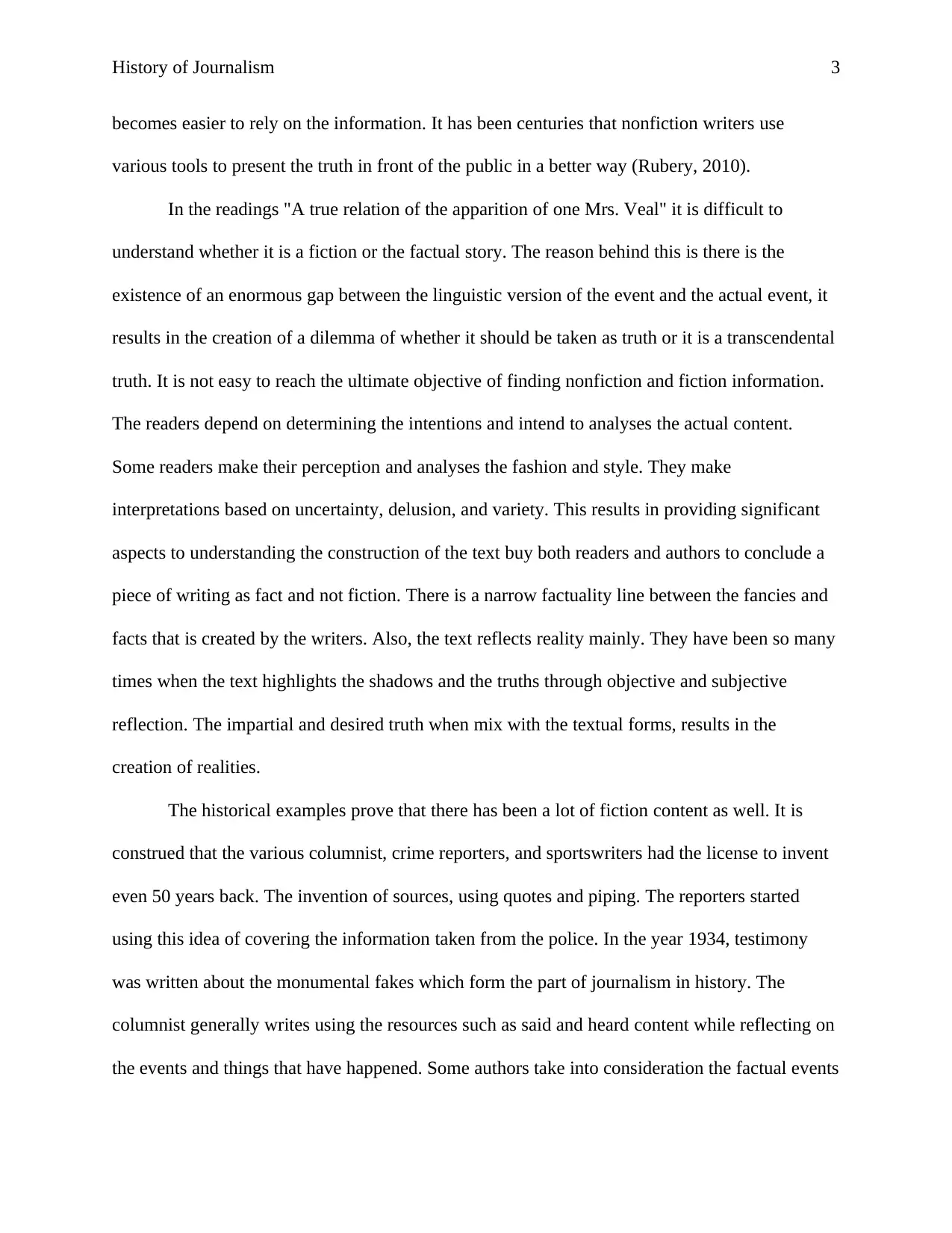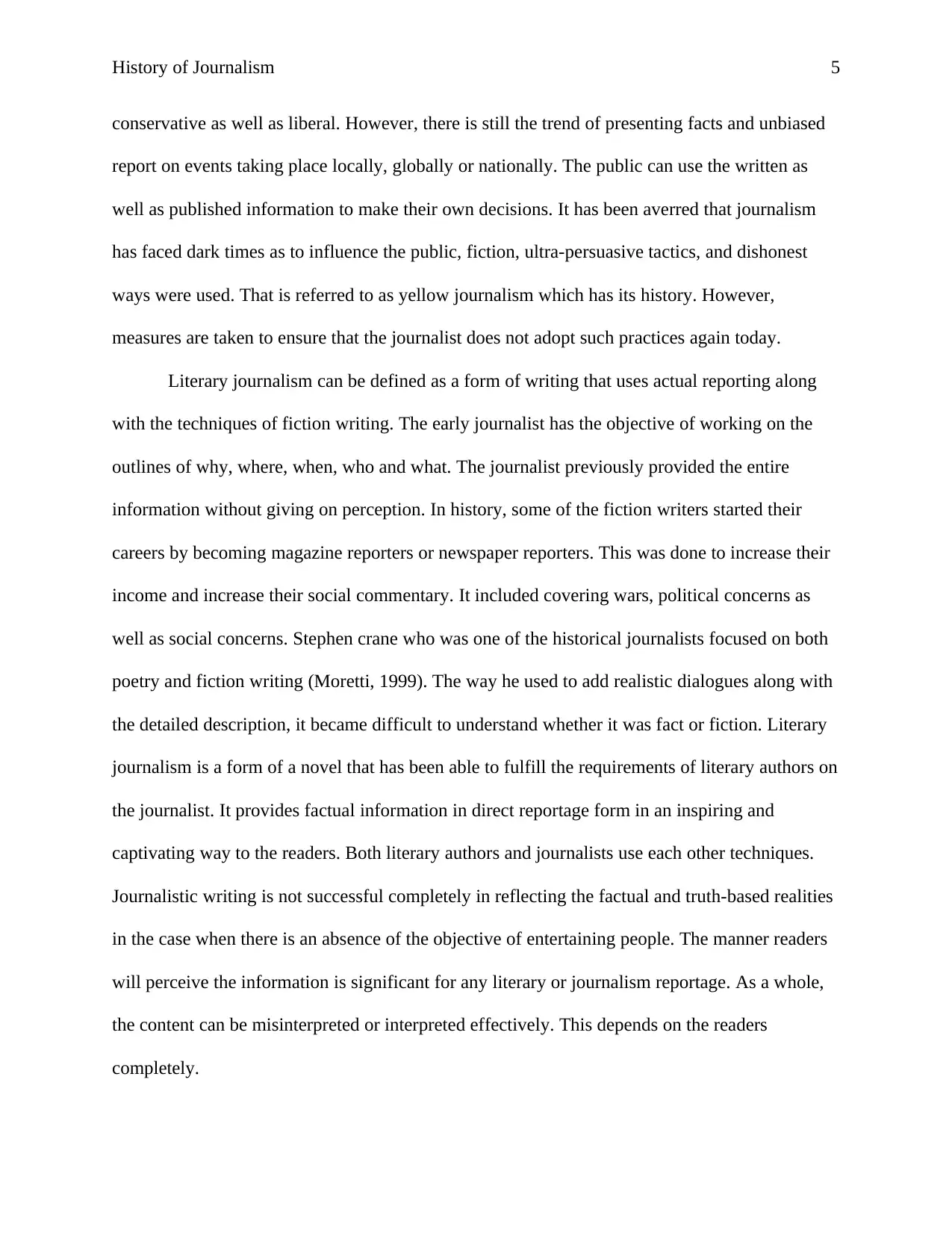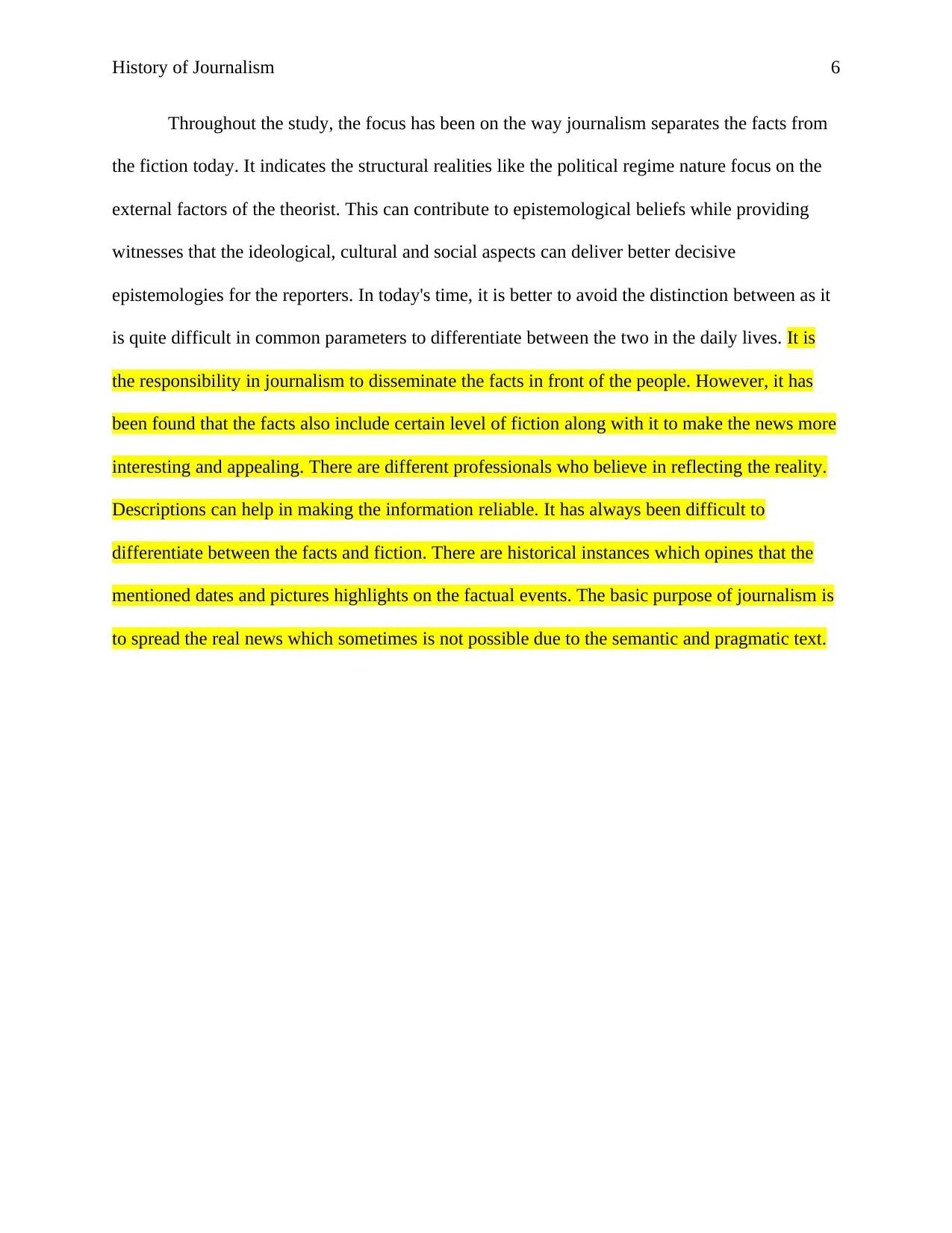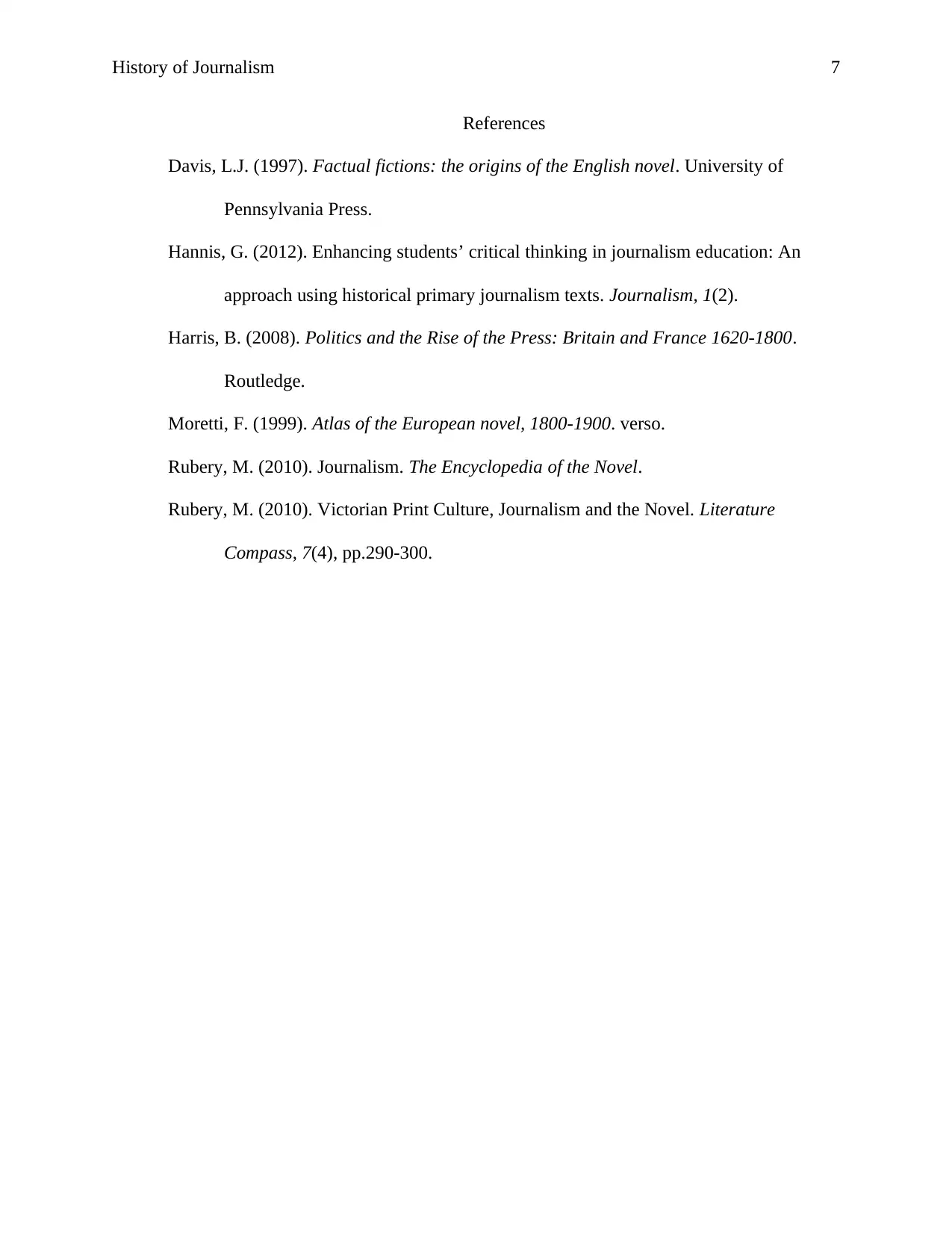History of Journalism: Assessing Fact and Fiction in Early Print Media
VerifiedAdded on 2022/08/18
|7
|1870
|11
Essay
AI Summary
This essay delves into the historical evolution of journalism, with a particular focus on the pre-1800 period and the interplay between fact and fiction in print media. The essay examines the resources available to early journalists in distinguishing between factual reporting and fictional narratives, and critically assesses how effectively these resources were utilized. The analysis considers the changing values within print journalism and the gradual shift towards prioritizing factual accuracy in reportage, using examples like Defoe's "A true relation of the apparition of one Mrs. Veal" to illustrate the challenges and complexities of this transition. The essay also touches upon the evolution of journalistic practices, the influence of technological advancements, and the societal factors that shaped the development of journalism as a profession and a source of information for the public. The work also explores the impact of yellow journalism and literary journalism.

Running head: History of Journalism 1
History of Journalism
Author Name(s), First M. Last, Omit Titles and Degrees
Institutional Affiliation(s)
Author Note
Include any grant/funding information and a complete correspondence address.
History of Journalism
Author Name(s), First M. Last, Omit Titles and Degrees
Institutional Affiliation(s)
Author Note
Include any grant/funding information and a complete correspondence address.
Paraphrase This Document
Need a fresh take? Get an instant paraphrase of this document with our AI Paraphraser

History of Journalism 2
Journalism is considered to be the process of collecting, organizing and spreading the
news. It includes commentaries and stories through a wide variety of media outlets. The
journalist can reflect reality. According to Rubery (2010), been stated that the news differentiates
from the truth and cannot be considered as the same thing. In the era of technological and
economic uncertainty, it is quite difficult to understand the depiction of a journalist.
The journalism includes the job of highlighting and disseminating the truth along with the
public. The main purpose of its existence is to provide the society with information about the
issues, people and events. Moreover, fiction creates confusion, doubt in reality and also affecting
the facts and the real news in the process. Therefore, the media must differentiate between the
facts and fiction using valuable resources. It is considered to be the most significant resource of
the journalist to differentiate between fact from fiction (Davis, 1997). Also, they got involved in
their research which appeared to be video corporate or disproved. In the readings, the first men
on the moon, 21 July 1969, it is based on personal experience and is factual information.
However, the detailed description and the written dialogues make it more interesting and are
reliable. It can be stated that print journalism values facts moreover fiction. The journalist is
expected to spread the news based on the truth. However, such a statement state between the
nonfiction reports from the expressions made in other forms. There is a novelist who tends to
deflect the truth concerning the conditions of human beings and society. Similarly, painters,
filmmakers, and poets along with the nonfiction writers highlight the reality. The fiction
journalist takes the help of facts to make them work more authentic. It is based on a higher level
of research. In the historical periods, there are so many chronicles which can be taken into
consideration. The journalist uses details and description so that the disbelief can fade and
Journalism is considered to be the process of collecting, organizing and spreading the
news. It includes commentaries and stories through a wide variety of media outlets. The
journalist can reflect reality. According to Rubery (2010), been stated that the news differentiates
from the truth and cannot be considered as the same thing. In the era of technological and
economic uncertainty, it is quite difficult to understand the depiction of a journalist.
The journalism includes the job of highlighting and disseminating the truth along with the
public. The main purpose of its existence is to provide the society with information about the
issues, people and events. Moreover, fiction creates confusion, doubt in reality and also affecting
the facts and the real news in the process. Therefore, the media must differentiate between the
facts and fiction using valuable resources. It is considered to be the most significant resource of
the journalist to differentiate between fact from fiction (Davis, 1997). Also, they got involved in
their research which appeared to be video corporate or disproved. In the readings, the first men
on the moon, 21 July 1969, it is based on personal experience and is factual information.
However, the detailed description and the written dialogues make it more interesting and are
reliable. It can be stated that print journalism values facts moreover fiction. The journalist is
expected to spread the news based on the truth. However, such a statement state between the
nonfiction reports from the expressions made in other forms. There is a novelist who tends to
deflect the truth concerning the conditions of human beings and society. Similarly, painters,
filmmakers, and poets along with the nonfiction writers highlight the reality. The fiction
journalist takes the help of facts to make them work more authentic. It is based on a higher level
of research. In the historical periods, there are so many chronicles which can be taken into
consideration. The journalist uses details and description so that the disbelief can fade and

History of Journalism 3
becomes easier to rely on the information. It has been centuries that nonfiction writers use
various tools to present the truth in front of the public in a better way (Rubery, 2010).
In the readings "A true relation of the apparition of one Mrs. Veal" it is difficult to
understand whether it is a fiction or the factual story. The reason behind this is there is the
existence of an enormous gap between the linguistic version of the event and the actual event, it
results in the creation of a dilemma of whether it should be taken as truth or it is a transcendental
truth. It is not easy to reach the ultimate objective of finding nonfiction and fiction information.
The readers depend on determining the intentions and intend to analyses the actual content.
Some readers make their perception and analyses the fashion and style. They make
interpretations based on uncertainty, delusion, and variety. This results in providing significant
aspects to understanding the construction of the text buy both readers and authors to conclude a
piece of writing as fact and not fiction. There is a narrow factuality line between the fancies and
facts that is created by the writers. Also, the text reflects reality mainly. They have been so many
times when the text highlights the shadows and the truths through objective and subjective
reflection. The impartial and desired truth when mix with the textual forms, results in the
creation of realities.
The historical examples prove that there has been a lot of fiction content as well. It is
construed that the various columnist, crime reporters, and sportswriters had the license to invent
even 50 years back. The invention of sources, using quotes and piping. The reporters started
using this idea of covering the information taken from the police. In the year 1934, testimony
was written about the monumental fakes which form the part of journalism in history. The
columnist generally writes using the resources such as said and heard content while reflecting on
the events and things that have happened. Some authors take into consideration the factual events
becomes easier to rely on the information. It has been centuries that nonfiction writers use
various tools to present the truth in front of the public in a better way (Rubery, 2010).
In the readings "A true relation of the apparition of one Mrs. Veal" it is difficult to
understand whether it is a fiction or the factual story. The reason behind this is there is the
existence of an enormous gap between the linguistic version of the event and the actual event, it
results in the creation of a dilemma of whether it should be taken as truth or it is a transcendental
truth. It is not easy to reach the ultimate objective of finding nonfiction and fiction information.
The readers depend on determining the intentions and intend to analyses the actual content.
Some readers make their perception and analyses the fashion and style. They make
interpretations based on uncertainty, delusion, and variety. This results in providing significant
aspects to understanding the construction of the text buy both readers and authors to conclude a
piece of writing as fact and not fiction. There is a narrow factuality line between the fancies and
facts that is created by the writers. Also, the text reflects reality mainly. They have been so many
times when the text highlights the shadows and the truths through objective and subjective
reflection. The impartial and desired truth when mix with the textual forms, results in the
creation of realities.
The historical examples prove that there has been a lot of fiction content as well. It is
construed that the various columnist, crime reporters, and sportswriters had the license to invent
even 50 years back. The invention of sources, using quotes and piping. The reporters started
using this idea of covering the information taken from the police. In the year 1934, testimony
was written about the monumental fakes which form the part of journalism in history. The
columnist generally writes using the resources such as said and heard content while reflecting on
the events and things that have happened. Some authors take into consideration the factual events
⊘ This is a preview!⊘
Do you want full access?
Subscribe today to unlock all pages.

Trusted by 1+ million students worldwide

History of Journalism 4
taking place from the actual transformation (Hannis, 2012). The objective is to reflect the reality
in the society. The factual reportage and representation of reality are considered to be illusionary
and defective as it is essential to understand the text to achieve the facts behind it. The
philosophical, pragmatic and semantic text construction leads to a distinction between the facts
and fiction. The columnist writes about his perception based on the opinion experiences gained
by him and also the news event. However, literary journalism constructed through the emotions
and attributes of the people. It might be a situation that the author wanted to spread a different
message and it has been taken differently by the readers due to the difference in opinion and
perception.
Yellow journalism was followed during the 1800s. It included covering large
personalities, tall tales and facts, and fiction. Yellow journalism was considered to be a
sensationalistic also biased stories that only showed the partial truth. In the 19th century, the
term was used by the journalists for the newly adopted techniques that were used by the rivalries.
Such journalism included the characteristics like scooping of stories, using multi-column
headlines, dominant graphics, and pictures that were oversized. The stories which were put on
the front page differentiated over the same concerns. Also, some reporters take advantage of
using anonymous sources mainly while investigating about famous people, big businessman or
political figures. Reportage can result in changing the minds of the readers and add some
sympathy. Traditionally, it formed the part of the imaginative literature. However, since the time
of reportage, it includes both facts and fiction to reach out to a large number of people who are
untouched by literature (Harris, 2008).
Since the early 1800s, the journalism social responsibility. Even today, the newspaper of
the country and the media outlets are recognized as social leanings which can be both
taking place from the actual transformation (Hannis, 2012). The objective is to reflect the reality
in the society. The factual reportage and representation of reality are considered to be illusionary
and defective as it is essential to understand the text to achieve the facts behind it. The
philosophical, pragmatic and semantic text construction leads to a distinction between the facts
and fiction. The columnist writes about his perception based on the opinion experiences gained
by him and also the news event. However, literary journalism constructed through the emotions
and attributes of the people. It might be a situation that the author wanted to spread a different
message and it has been taken differently by the readers due to the difference in opinion and
perception.
Yellow journalism was followed during the 1800s. It included covering large
personalities, tall tales and facts, and fiction. Yellow journalism was considered to be a
sensationalistic also biased stories that only showed the partial truth. In the 19th century, the
term was used by the journalists for the newly adopted techniques that were used by the rivalries.
Such journalism included the characteristics like scooping of stories, using multi-column
headlines, dominant graphics, and pictures that were oversized. The stories which were put on
the front page differentiated over the same concerns. Also, some reporters take advantage of
using anonymous sources mainly while investigating about famous people, big businessman or
political figures. Reportage can result in changing the minds of the readers and add some
sympathy. Traditionally, it formed the part of the imaginative literature. However, since the time
of reportage, it includes both facts and fiction to reach out to a large number of people who are
untouched by literature (Harris, 2008).
Since the early 1800s, the journalism social responsibility. Even today, the newspaper of
the country and the media outlets are recognized as social leanings which can be both
Paraphrase This Document
Need a fresh take? Get an instant paraphrase of this document with our AI Paraphraser

History of Journalism 5
conservative as well as liberal. However, there is still the trend of presenting facts and unbiased
report on events taking place locally, globally or nationally. The public can use the written as
well as published information to make their own decisions. It has been averred that journalism
has faced dark times as to influence the public, fiction, ultra-persuasive tactics, and dishonest
ways were used. That is referred to as yellow journalism which has its history. However,
measures are taken to ensure that the journalist does not adopt such practices again today.
Literary journalism can be defined as a form of writing that uses actual reporting along
with the techniques of fiction writing. The early journalist has the objective of working on the
outlines of why, where, when, who and what. The journalist previously provided the entire
information without giving on perception. In history, some of the fiction writers started their
careers by becoming magazine reporters or newspaper reporters. This was done to increase their
income and increase their social commentary. It included covering wars, political concerns as
well as social concerns. Stephen crane who was one of the historical journalists focused on both
poetry and fiction writing (Moretti, 1999). The way he used to add realistic dialogues along with
the detailed description, it became difficult to understand whether it was fact or fiction. Literary
journalism is a form of a novel that has been able to fulfill the requirements of literary authors on
the journalist. It provides factual information in direct reportage form in an inspiring and
captivating way to the readers. Both literary authors and journalists use each other techniques.
Journalistic writing is not successful completely in reflecting the factual and truth-based realities
in the case when there is an absence of the objective of entertaining people. The manner readers
will perceive the information is significant for any literary or journalism reportage. As a whole,
the content can be misinterpreted or interpreted effectively. This depends on the readers
completely.
conservative as well as liberal. However, there is still the trend of presenting facts and unbiased
report on events taking place locally, globally or nationally. The public can use the written as
well as published information to make their own decisions. It has been averred that journalism
has faced dark times as to influence the public, fiction, ultra-persuasive tactics, and dishonest
ways were used. That is referred to as yellow journalism which has its history. However,
measures are taken to ensure that the journalist does not adopt such practices again today.
Literary journalism can be defined as a form of writing that uses actual reporting along
with the techniques of fiction writing. The early journalist has the objective of working on the
outlines of why, where, when, who and what. The journalist previously provided the entire
information without giving on perception. In history, some of the fiction writers started their
careers by becoming magazine reporters or newspaper reporters. This was done to increase their
income and increase their social commentary. It included covering wars, political concerns as
well as social concerns. Stephen crane who was one of the historical journalists focused on both
poetry and fiction writing (Moretti, 1999). The way he used to add realistic dialogues along with
the detailed description, it became difficult to understand whether it was fact or fiction. Literary
journalism is a form of a novel that has been able to fulfill the requirements of literary authors on
the journalist. It provides factual information in direct reportage form in an inspiring and
captivating way to the readers. Both literary authors and journalists use each other techniques.
Journalistic writing is not successful completely in reflecting the factual and truth-based realities
in the case when there is an absence of the objective of entertaining people. The manner readers
will perceive the information is significant for any literary or journalism reportage. As a whole,
the content can be misinterpreted or interpreted effectively. This depends on the readers
completely.

History of Journalism 6
Throughout the study, the focus has been on the way journalism separates the facts from
the fiction today. It indicates the structural realities like the political regime nature focus on the
external factors of the theorist. This can contribute to epistemological beliefs while providing
witnesses that the ideological, cultural and social aspects can deliver better decisive
epistemologies for the reporters. In today's time, it is better to avoid the distinction between as it
is quite difficult in common parameters to differentiate between the two in the daily lives. It is
the responsibility in journalism to disseminate the facts in front of the people. However, it has
been found that the facts also include certain level of fiction along with it to make the news more
interesting and appealing. There are different professionals who believe in reflecting the reality.
Descriptions can help in making the information reliable. It has always been difficult to
differentiate between the facts and fiction. There are historical instances which opines that the
mentioned dates and pictures highlights on the factual events. The basic purpose of journalism is
to spread the real news which sometimes is not possible due to the semantic and pragmatic text.
Throughout the study, the focus has been on the way journalism separates the facts from
the fiction today. It indicates the structural realities like the political regime nature focus on the
external factors of the theorist. This can contribute to epistemological beliefs while providing
witnesses that the ideological, cultural and social aspects can deliver better decisive
epistemologies for the reporters. In today's time, it is better to avoid the distinction between as it
is quite difficult in common parameters to differentiate between the two in the daily lives. It is
the responsibility in journalism to disseminate the facts in front of the people. However, it has
been found that the facts also include certain level of fiction along with it to make the news more
interesting and appealing. There are different professionals who believe in reflecting the reality.
Descriptions can help in making the information reliable. It has always been difficult to
differentiate between the facts and fiction. There are historical instances which opines that the
mentioned dates and pictures highlights on the factual events. The basic purpose of journalism is
to spread the real news which sometimes is not possible due to the semantic and pragmatic text.
⊘ This is a preview!⊘
Do you want full access?
Subscribe today to unlock all pages.

Trusted by 1+ million students worldwide

History of Journalism 7
References
Davis, L.J. (1997). Factual fictions: the origins of the English novel. University of
Pennsylvania Press.
Hannis, G. (2012). Enhancing students’ critical thinking in journalism education: An
approach using historical primary journalism texts. Journalism, 1(2).
Harris, B. (2008). Politics and the Rise of the Press: Britain and France 1620-1800.
Routledge.
Moretti, F. (1999). Atlas of the European novel, 1800-1900. verso.
Rubery, M. (2010). Journalism. The Encyclopedia of the Novel.
Rubery, M. (2010). Victorian Print Culture, Journalism and the Novel. Literature
Compass, 7(4), pp.290-300.
References
Davis, L.J. (1997). Factual fictions: the origins of the English novel. University of
Pennsylvania Press.
Hannis, G. (2012). Enhancing students’ critical thinking in journalism education: An
approach using historical primary journalism texts. Journalism, 1(2).
Harris, B. (2008). Politics and the Rise of the Press: Britain and France 1620-1800.
Routledge.
Moretti, F. (1999). Atlas of the European novel, 1800-1900. verso.
Rubery, M. (2010). Journalism. The Encyclopedia of the Novel.
Rubery, M. (2010). Victorian Print Culture, Journalism and the Novel. Literature
Compass, 7(4), pp.290-300.
1 out of 7
Your All-in-One AI-Powered Toolkit for Academic Success.
+13062052269
info@desklib.com
Available 24*7 on WhatsApp / Email
![[object Object]](/_next/static/media/star-bottom.7253800d.svg)
Unlock your academic potential
Copyright © 2020–2025 A2Z Services. All Rights Reserved. Developed and managed by ZUCOL.
